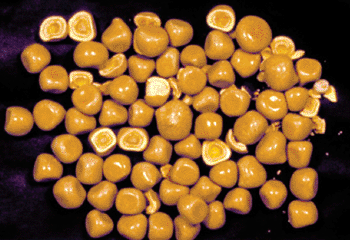Macrophage-Derived Mediators Are Urolithiasis Risk Biomarkers
By LabMedica International staff writers
Posted on 14 Oct 2013
Macrophage-derived cytokines and chemokines may be novel markers to predict calcium oxalate stone formation in humans. Posted on 14 Oct 2013
A balance between the activation of the inflammatory macrophages and suppression of the anti-inflammatory macrophages in the kidney may play a pivotal role in kidney stone formation (urolithiasis).

Image: Calcium Oxalate Kidney Stones (Photo courtesy of Mission Pharmacal Company).
Scientists at the Nagoya City University (Japan) identified urinary Type 2 macrophage (M2) associated markers, by performing multiplex urinalysis in individuals prone to developing calcium oxalate kidney stones. They were able to observe that stone-formers had higher-level urinary Type 1 macrophages (M1) markers, whereas non-stone-formers had a higher level of M2 markers.
Compared to that of control subjects, the urine from individuals with a history of kidney stone formation showed significantly increased levels of the inflammatory chemokines growth-related oncogene (GRO) and chemokine (C-X-C motif) ligand 1 (CXCL1). The patients with urolithiasis had significantly decreased levels of interleukin-4 (IL-4), an anti-inflammatory cytokine involved in macrophage migration.
Atsushi Okada, MD, PhD, the lead investigator of the study said, “To date, the risk evaluation and the preventive index of kidney stone formation have been dependent on urinary inorganic matter such as calcium, phosphorus, magnesium, uric acid, oxalate and citrate. However, stone formers don't often show such an abnormality. In a series of preceding studies, we examined organic substance in kidney stones, such as protein from kidney tissue, and revealed that stone matrix and genetic environment of renal tubular cells are as important as urinary inorganic condition for kidney stone formation. “
Dr. Okada believes that this study may have pronounced implications for clinical practice, and added, "If the usefulness of these macrophage markers is established, it will be possible to evaluate kidney stone risk not only through inorganic but also some organic substances. Furthermore, these results may lead to the development of new therapeutic drugs for kidney stone formation to control macrophage function.” The study was presented at 2nd Meeting of the European Association of Urology Section of Urolithiasis held September 5-7, 2013, in Copenhagen (Denmark).
Related Links:
Nagoya City University







 assay.jpg)






